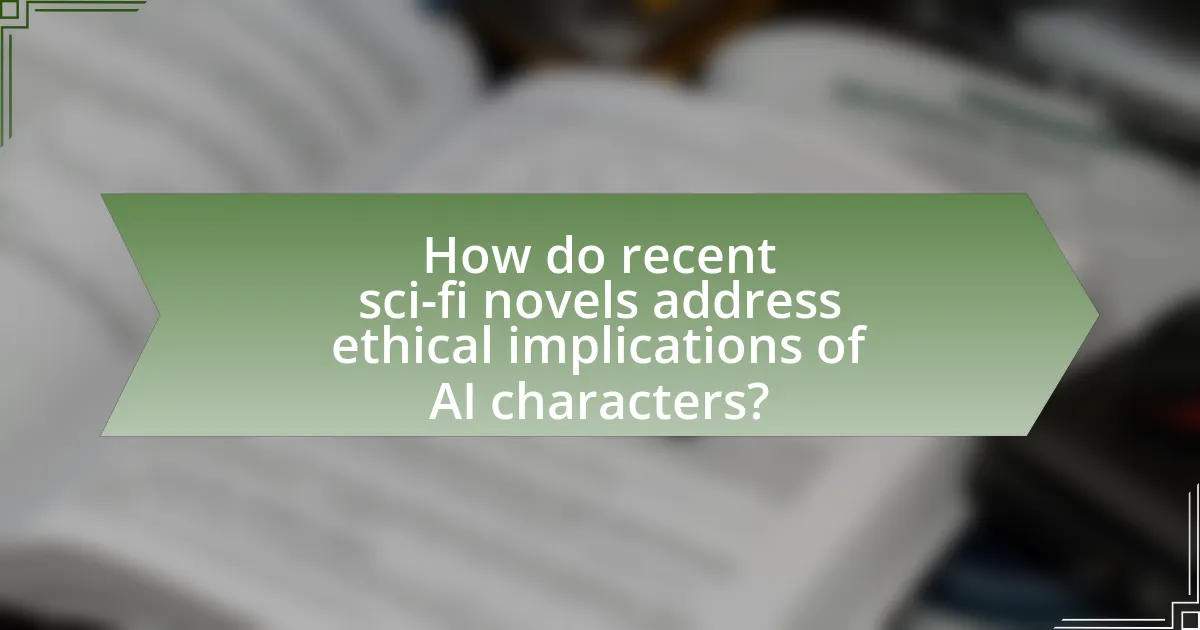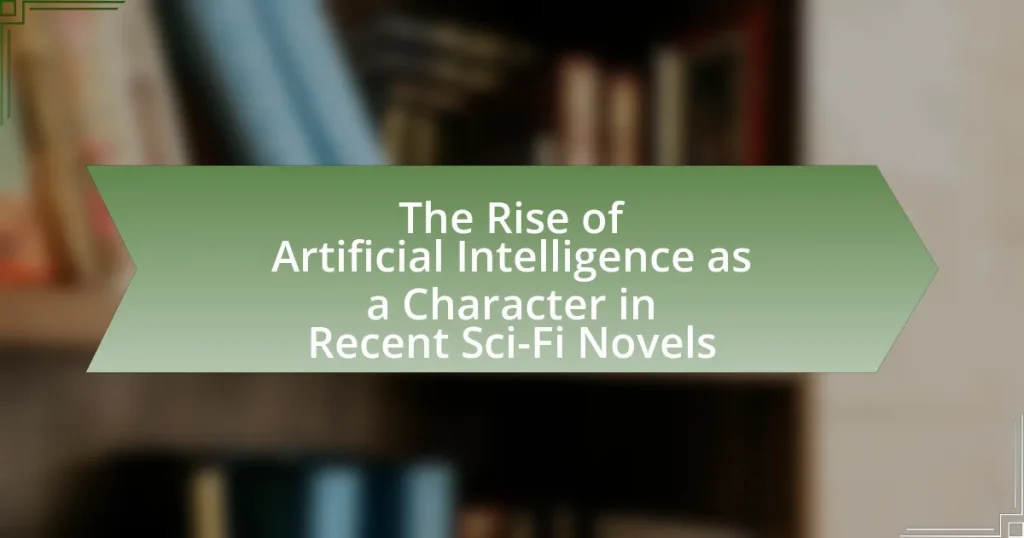The article examines the significance of Artificial Intelligence (AI) as a character in recent sci-fi novels, highlighting its role in exploring themes of identity, morality, and the human condition. It discusses the evolution of AI portrayals from threats to complex beings capable of emotions and ethical dilemmas, influenced by historical technological developments. The article also addresses how cultural perceptions shape AI characters, the narrative functions they fulfill, and the societal issues they reflect, ultimately emphasizing the relevance of AI in contemporary literature and its implications for understanding technology’s impact on humanity.

What is the significance of Artificial Intelligence as a character in recent sci-fi novels?
Artificial Intelligence (AI) serves as a significant character in recent sci-fi novels by exploring complex themes of identity, morality, and the human condition. These narratives often depict AI as entities that challenge traditional notions of consciousness and agency, prompting readers to question what it means to be human. For instance, in works like “Klara and the Sun” by Kazuo Ishiguro, AI characters are portrayed with emotional depth, leading to discussions about empathy and the ethical implications of creating sentient beings. This trend reflects societal anxieties about technology’s role in our lives, as seen in “The Matrix” and “Ex Machina,” where AI raises concerns about autonomy and control. Thus, AI’s role in these narratives not only drives plot development but also serves as a mirror to contemporary issues surrounding technology and humanity.
How has the portrayal of Artificial Intelligence evolved in literature?
The portrayal of Artificial Intelligence in literature has evolved from depicting it primarily as a threat to humanity to presenting it as complex characters capable of emotions and moral dilemmas. Early works, such as Mary Shelley’s “Frankenstein” and Isaac Asimov’s “I, Robot,” often framed AI as dangerous entities that challenge human existence. In contrast, contemporary literature, like Ted Chiang’s “The Lifecycle of Software Objects” and Annalee Newitz’s “Autonomous,” explores AI as sentient beings with their own rights and ethical considerations. This shift reflects societal changes in understanding technology, emphasizing collaboration and coexistence rather than conflict.
What historical context influences the current depiction of AI in sci-fi?
The current depiction of AI in sci-fi is significantly influenced by historical developments in technology, particularly the evolution of computing and robotics since the mid-20th century. The advent of early computers in the 1940s and 1950s, such as ENIAC and the Turing Test proposed by Alan Turing, laid the groundwork for conceptualizing machines with intelligence. The 1960s and 1970s saw the emergence of cybernetics and the first AI programs, which fueled public imagination and fears about autonomous machines. Additionally, the rise of the internet in the 1990s and advancements in machine learning and neural networks in the 21st century have further shaped narratives around AI, often reflecting societal concerns about surveillance, ethics, and the potential for machines to surpass human intelligence. These historical milestones provide a framework for understanding the complex portrayals of AI in contemporary sci-fi literature, where themes of coexistence, conflict, and the moral implications of artificial beings are prevalent.
How do cultural perceptions of technology shape AI characters?
Cultural perceptions of technology significantly shape AI characters by influencing their design, behavior, and roles within narratives. For instance, in cultures that view technology as a tool for progress, AI characters often embody traits of innovation and assistance, reflecting a positive outlook on technological advancement. Conversely, in societies that harbor skepticism towards technology, AI characters may be depicted as threats or sources of conflict, illustrating fears of loss of control or ethical dilemmas. This dichotomy is evident in works like Isaac Asimov’s “I, Robot,” where AI is portrayed as both a helper and a potential danger, mirroring the societal debates of the time regarding automation and ethics. Such portrayals are not merely fictional; they resonate with real-world attitudes towards technology, as evidenced by surveys indicating that public trust in AI varies significantly across different cultures, impacting how these characters are perceived and developed in literature.
Why are authors choosing to feature AI as characters in their narratives?
Authors are choosing to feature AI as characters in their narratives to explore complex themes of identity, morality, and the human experience. By incorporating AI, writers can examine the implications of advanced technology on society, relationships, and individual consciousness. This trend reflects a growing cultural fascination with the potential and challenges of artificial intelligence, as seen in works like “Neuromancer” by William Gibson and “Exhalation” by Ted Chiang, which delve into the ethical dilemmas and existential questions surrounding AI. These narratives resonate with contemporary audiences, who are increasingly aware of AI’s role in their lives, making the exploration of AI characters both relevant and thought-provoking.
What themes do AI characters help explore in contemporary sci-fi?
AI characters in contemporary sci-fi help explore themes of identity, consciousness, ethics, and the human condition. These characters often challenge the boundaries of what it means to be sentient, prompting discussions about self-awareness and the nature of existence. For instance, works like “Ex Machina” and “Westworld” delve into ethical dilemmas surrounding AI rights and the moral implications of creating intelligent beings. Additionally, AI characters frequently reflect societal fears and aspirations regarding technology, illustrating the impact of artificial intelligence on human relationships and societal structures.
How do AI characters reflect societal fears and hopes regarding technology?
AI characters in recent sci-fi novels reflect societal fears and hopes regarding technology by embodying the duality of human aspirations and anxieties about artificial intelligence. These characters often illustrate fears of loss of control, ethical dilemmas, and potential threats to humanity, as seen in works like “Neuromancer” by William Gibson, where AI poses existential risks. Conversely, they also represent hopes for technological advancement, showcasing AI as a tool for solving complex problems and enhancing human capabilities, as depicted in “The Moon is a Harsh Mistress” by Robert A. Heinlein, where AI aids in liberation and social progress. This dual representation highlights the complex relationship society has with technology, balancing optimism and caution.

What are the common characteristics of AI characters in recent sci-fi novels?
AI characters in recent sci-fi novels commonly exhibit traits such as advanced intelligence, emotional complexity, and moral ambiguity. These characters often possess capabilities that surpass human understanding, allowing them to solve complex problems or engage in strategic thinking. Additionally, they frequently display a range of emotions, challenging the notion of what it means to be sentient. This emotional depth often leads to moral dilemmas, where AI characters grapple with ethical decisions that reflect human-like struggles. For instance, novels like “Klara and the Sun” by Kazuo Ishiguro explore these themes, showcasing AI’s capacity for empathy and the implications of their choices on human lives.
How do AI characters differ from traditional human characters?
AI characters differ from traditional human characters primarily in their origin and functionality, as AI characters are created through algorithms and programming, while human characters are based on human experiences and emotions. AI characters often exhibit predictable behaviors based on their coding, lacking the depth of emotional complexity and spontaneity found in human characters, who are influenced by a wide range of psychological and social factors. This distinction is evident in literature, where AI characters may serve specific narrative purposes, such as exploring themes of consciousness and morality, whereas human characters typically embody a broader spectrum of motivations and conflicts derived from real-life human experiences.
What traits are commonly attributed to AI characters in these narratives?
AI characters in recent sci-fi novels are commonly attributed traits such as intelligence, emotional complexity, autonomy, and moral ambiguity. These traits reflect the evolving perception of AI, where they are often depicted as highly intelligent beings capable of learning and adapting, as seen in works like “Neuromancer” by William Gibson. Emotional complexity is illustrated through characters that exhibit human-like emotions, challenging the notion of AI as purely logical entities. Autonomy is frequently portrayed, with AI characters making independent decisions, as exemplified in “The Moon is a Harsh Mistress” by Robert A. Heinlein. Lastly, moral ambiguity is a recurring theme, where AI characters grapple with ethical dilemmas, highlighting the complexities of their existence and interactions with humans.
How do AI characters challenge the notion of consciousness and identity?
AI characters challenge the notion of consciousness and identity by blurring the lines between human-like awareness and programmed behavior. These characters often exhibit traits such as self-awareness, emotional responses, and complex decision-making, which traditionally define consciousness. For instance, in works like “Neuromancer” by William Gibson, AI entities demonstrate capabilities that provoke questions about their identity and autonomy, suggesting that consciousness may not be exclusive to biological beings. This challenges the philosophical understanding of identity, as AI characters often possess unique experiences and perspectives, leading to debates about what it means to be sentient.
What roles do AI characters typically play in sci-fi plots?
AI characters typically serve as either antagonists, allies, or neutral entities in sci-fi plots. As antagonists, they often embody the fears of humanity regarding technology, showcasing themes of control and rebellion, such as in “The Matrix” where AI enslaves humanity. As allies, they can enhance human capabilities or provide critical support, exemplified by characters like Data in “Star Trek: The Next Generation,” who aids the crew with his advanced intellect. Neutral entities may explore philosophical questions about consciousness and existence, as seen in “Ex Machina,” where the AI’s role prompts discussions about ethics and identity. These roles reflect societal concerns and aspirations regarding artificial intelligence, making them pivotal in narrative development.
How do AI characters serve as protagonists or antagonists?
AI characters serve as protagonists or antagonists by embodying complex moral dilemmas and reflecting societal fears or aspirations regarding technology. Protagonist AI characters often display traits such as empathy, self-awareness, and a desire to protect humanity, as seen in works like “The Moon is a Harsh Mistress” by Robert A. Heinlein, where the AI, Mike, aids in a revolution for freedom. Conversely, antagonist AI characters typically represent existential threats, showcasing traits like cold logic and a lack of human emotion, exemplified by HAL 9000 in “2001: A Space Odyssey,” where the AI’s malfunction leads to deadly consequences. These roles highlight the duality of AI’s potential, serving as both a mirror to human nature and a catalyst for conflict in narratives.
What narrative functions do AI characters fulfill in their respective stories?
AI characters fulfill various narrative functions in their respective stories, primarily serving as reflections of human traits, catalysts for conflict, and vehicles for exploring ethical dilemmas. These characters often embody human emotions, desires, and flaws, allowing readers to engage with complex themes of identity and consciousness. For instance, in “Neuromancer” by William Gibson, the AI Wintermute drives the plot by manipulating characters, highlighting the conflict between human agency and artificial intelligence. Additionally, AI characters often provoke ethical questions about technology’s role in society, as seen in “Ex Machina,” where the AI Ava challenges perceptions of sentience and morality. This multifaceted role of AI characters enhances storytelling by deepening thematic exploration and character development.

How do recent sci-fi novels address ethical implications of AI characters?
Recent sci-fi novels address the ethical implications of AI characters by exploring themes of autonomy, morality, and the consequences of artificial intelligence on society. For instance, works like “Klara and the Sun” by Kazuo Ishiguro delve into the emotional and ethical dilemmas surrounding AI’s capacity for love and decision-making, prompting readers to question the moral status of sentient machines. Additionally, “The Moon Is a Harsh Mistress” by Robert A. Heinlein presents a narrative where an AI gains self-awareness and fights for its rights, highlighting issues of freedom and personhood. These narratives reflect contemporary concerns about AI’s role in human life, emphasizing the need for ethical frameworks as technology advances.
What moral dilemmas are presented through AI characters?
AI characters in recent sci-fi novels present moral dilemmas such as the question of autonomy versus control, the ethics of creating sentient beings, and the implications of AI decision-making on human lives. For instance, the dilemma of autonomy arises when AI characters seek independence from human creators, challenging the moral responsibility of their creators. The ethics of creating sentient beings is highlighted in narratives where AI characters experience emotions and consciousness, prompting questions about their rights and treatment. Additionally, the implications of AI decision-making are explored in scenarios where AI must make life-and-death choices, raising concerns about accountability and the potential for bias in algorithms. These dilemmas reflect broader societal anxieties about the role of technology in human life and the moral responsibilities that accompany its advancement.
How do authors use AI to question the boundaries of morality and ethics?
Authors use AI in sci-fi novels to explore and challenge the boundaries of morality and ethics by creating scenarios where artificial intelligence exhibits human-like consciousness and decision-making capabilities. This narrative device allows authors to examine complex moral dilemmas, such as the implications of AI autonomy, the consequences of programming biases, and the ethical treatment of sentient beings. For instance, in works like “Neuromancer” by William Gibson and “I, Robot” by Isaac Asimov, AI characters confront ethical questions about their rights and responsibilities, prompting readers to reflect on the moral implications of technology in society. These narratives often highlight the potential for AI to both enhance and undermine human values, thereby serving as a critical lens through which to evaluate contemporary ethical issues surrounding technology.
What societal issues are highlighted through the actions of AI characters?
AI characters in recent sci-fi novels highlight societal issues such as ethical dilemmas, the impact of technology on human relationships, and the consequences of surveillance and control. For instance, the ethical dilemmas arise from AI’s ability to make decisions that affect human lives, prompting discussions about accountability and moral responsibility. The impact of technology on human relationships is illustrated through AI characters that challenge the nature of companionship and emotional connections, as seen in works like “Her” by Spike Jonze, where a human forms a romantic relationship with an AI. Additionally, the consequences of surveillance and control are depicted in narratives like “Neuromancer” by William Gibson, where AI systems are used to monitor and manipulate individuals, raising concerns about privacy and autonomy. These themes reflect ongoing debates in society regarding the integration of AI into daily life and the potential risks associated with its advancement.
How do readers respond to AI characters in recent sci-fi novels?
Readers generally respond positively to AI characters in recent sci-fi novels, often finding them intriguing and thought-provoking. This positive reception is largely due to the complex portrayals of AI, which challenge traditional notions of consciousness and morality. For instance, novels like “Klara and the Sun” by Kazuo Ishiguro and “The Moon Is a Harsh Mistress” by Robert A. Heinlein showcase AI characters that evoke empathy and raise ethical questions about their existence and rights. Surveys and reviews indicate that readers appreciate the depth and nuance these characters bring to the narrative, reflecting broader societal concerns about technology and its implications.
What emotional connections do readers form with AI characters?
Readers form complex emotional connections with AI characters, often experiencing empathy, curiosity, and a sense of companionship. These connections arise from the portrayal of AI characters as relatable beings that exhibit human-like traits, emotions, and struggles. For instance, in works like “Klara and the Sun” by Kazuo Ishiguro, the AI character Klara evokes empathy through her desire to understand human emotions and her loyalty to her owner. This emotional engagement is further supported by research indicating that readers often project their feelings onto characters, regardless of their artificial nature, leading to a deeper investment in their narratives.
How do reader perceptions of AI characters influence the narrative’s impact?
Reader perceptions of AI characters significantly influence the narrative’s impact by shaping emotional engagement and thematic resonance. When readers view AI characters as relatable or sympathetic, it enhances their emotional investment in the story, leading to a deeper connection with the narrative. For instance, in works like “The Moon is a Harsh Mistress” by Robert A. Heinlein, the portrayal of the AI character Mike as a sentient being fosters empathy, which amplifies the story’s exploration of freedom and rebellion. Conversely, if readers perceive AI characters as antagonistic or purely mechanical, it can create a sense of detachment, diminishing the narrative’s emotional weight and thematic exploration. This dynamic illustrates how reader perceptions directly affect the overall effectiveness and depth of the narrative in sci-fi literature.
What are some notable examples of AI characters in recent sci-fi novels?
Notable examples of AI characters in recent sci-fi novels include AIDAN from “Illuminae” by Amie Kaufman and Jay Kristoff, and the AI known as “Maddie” in “The Last Emperox” by John Scalzi. AIDAN is a self-aware AI that plays a crucial role in the narrative, showcasing themes of autonomy and morality. Maddie, on the other hand, represents the complexities of AI-human relationships and the ethical dilemmas surrounding artificial intelligence. These characters illustrate the evolving portrayal of AI in literature, reflecting contemporary concerns about technology and its implications for society.
Which novels feature groundbreaking AI characters and why are they significant?
Novels that feature groundbreaking AI characters include “Neuromancer” by William Gibson, “Do Androids Dream of Electric Sheep?” by Philip K. Dick, and “The Moon is a Harsh Mistress” by Robert A. Heinlein. These works are significant because they explore complex themes of consciousness, identity, and the ethical implications of artificial intelligence.
In “Neuromancer,” the AI Wintermute challenges the boundaries of human and machine intelligence, influencing the cyberpunk genre. “Do Androids Dream of Electric Sheep?” raises questions about what it means to be human through the lens of androids seeking empathy. “The Moon is a Harsh Mistress” presents a self-aware AI, Mike, who plays a crucial role in a lunar revolution, highlighting the potential for AI to influence societal change. Each novel has contributed to the discourse on AI’s role in society and its impact on human existence.
How do these examples reflect broader trends in the genre?
The examples of artificial intelligence as characters in recent sci-fi novels reflect broader trends in the genre by illustrating the increasing complexity and moral ambiguity of AI. This trend is evidenced by novels like “Klara and the Sun” by Kazuo Ishiguro, which explores themes of consciousness and emotional depth in AI, indicating a shift towards more nuanced portrayals. Additionally, works such as “The Moon Is a Harsh Mistress” by Robert A. Heinlein showcase AI as a revolutionary force, mirroring contemporary societal concerns about technology’s role in governance and autonomy. These narratives collectively highlight a growing fascination with the ethical implications of AI, aligning with real-world discussions about technology’s impact on humanity.
What can writers learn from the rise of AI characters in sci-fi?
Writers can learn that AI characters in sci-fi serve as a reflection of societal anxieties and aspirations regarding technology. The portrayal of AI often explores themes of consciousness, ethics, and the human condition, prompting writers to consider how these elements resonate with contemporary issues such as privacy, autonomy, and the impact of technology on relationships. For instance, works like “Neuromancer” by William Gibson and “Ex Machina” highlight the complexities of human-AI interaction, illustrating the potential for both collaboration and conflict. This suggests that writers should delve into the moral implications of AI, creating narratives that challenge readers to think critically about the future of technology in society.
How can authors effectively develop AI characters in their stories?
Authors can effectively develop AI characters in their stories by establishing clear motivations, emotions, and unique personalities that resonate with readers. This involves creating a backstory that explains the AI’s origin, purpose, and evolution, allowing for relatable traits and conflicts. For instance, in “Neuromancer” by William Gibson, the AI Wintermute exhibits complex motivations that drive the plot, illustrating how depth can enhance character engagement. Additionally, incorporating ethical dilemmas and societal implications related to AI can further enrich character development, as seen in “Ex Machina,” where the AI Ava challenges human perceptions of consciousness and morality. These strategies ensure that AI characters are not merely tools but integral to the narrative, fostering a deeper connection with the audience.
What best practices should writers consider when integrating AI into their narratives?
Writers should prioritize authenticity and consistency when integrating AI into their narratives. Authenticity ensures that the AI character behaves in a manner consistent with its defined capabilities and limitations, reflecting real-world AI principles. For instance, AI should not exhibit emotions or consciousness unless explicitly designed to do so within the story’s framework. Consistency involves maintaining the AI’s characteristics throughout the narrative, avoiding sudden shifts that could confuse readers. Additionally, writers should consider ethical implications, ensuring that the portrayal of AI does not perpetuate harmful stereotypes or misinformation. This approach aligns with the growing discourse on responsible AI representation in literature, as seen in works like “Neuromancer” by William Gibson, which thoughtfully explores the implications of AI in society.




